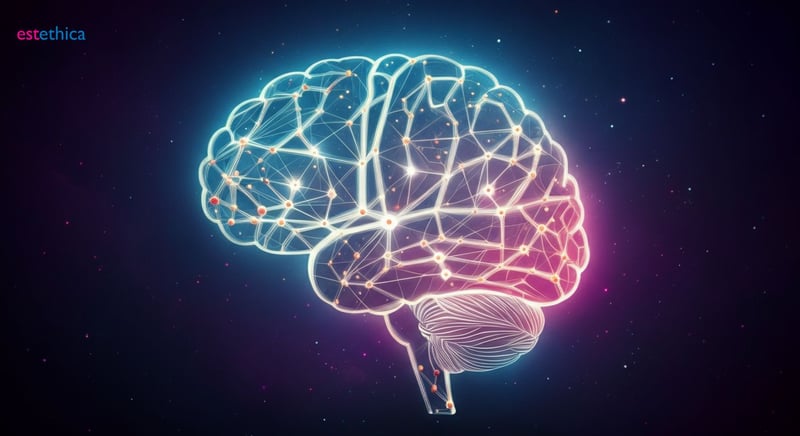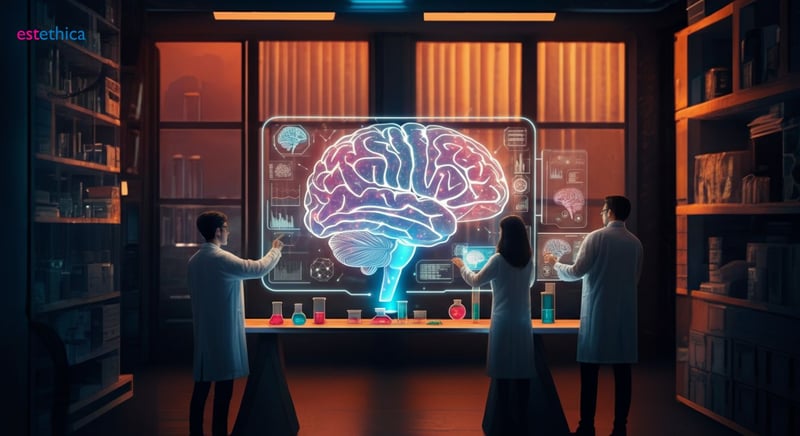Decode the Future: Mastering Machine Learning Essentials
Discover the transformative power of AI and machine learning in this comprehensive guide.
In the modern digital age, knowing how to navigate the intricate world of machine learning is akin to possessing a superpower. This article takes you on a journey from understanding the basics of artificial intelligence to mastering complex neural network strategies, equipping you with the tools needed to thrive in today's tech-driven landscape.
Unlocking AI: A Beginner's Guide to Artificial Intelligence
Understanding the Core of Artificial Intelligence
Artificial Intelligence (AI) is rapidly transforming our world, impacting everything from how we work to how we interact with technology. At its core, AI involves creating machines capable of performing tasks that typically require human intelligence. This includes not only complex problem-solving but also more nuanced activities like understanding natural language and recognizing patterns. AI systems achieve this through various techniques, including machine learning, deep learning, and neural networks, enabling them to learn from data, adapt to new situations, and make decisions with minimal human intervention. As AI continues to evolve, it promises to unlock new possibilities across industries, enhancing efficiency, driving innovation, and creating solutions to some of the world's most pressing challenges.
- Enhanced Productivity: AI automates repetitive tasks, freeing up human workers to focus on more creative and strategic activities.
- Improved Decision-Making: AI algorithms can analyze vast amounts of data to identify trends and insights, leading to better-informed decisions.
- Personalized Experiences: AI enables businesses to tailor products and services to individual customer needs, enhancing satisfaction and loyalty.
Embarking on Your AI Learning Journey
Starting your journey into the world of AI can be both exciting and rewarding. The first step is to grasp the fundamental concepts and principles that underpin AI technologies. Begin by exploring introductory courses and tutorials that cover topics such as machine learning, data science, and neural networks. These resources provide a solid foundation and help you understand the different approaches to AI development. Additionally, consider engaging with online communities and forums where you can connect with other learners, ask questions, and share your progress. Remember that mastering AI is a continuous process of learning and experimentation. Embrace the challenges, stay curious, and gradually build your skills through hands-on projects and real-world applications. With dedication and perseverance, you can unlock the potential of AI and contribute to its transformative impact on society. Understanding how to learn artificial intelligence effectively is key to staying ahead in this rapidly evolving field.
- Foundational Knowledge: Start with basic concepts in mathematics, statistics, and computer science to build a strong base.
- Online Courses: Enroll in courses on platforms like Coursera and Udacity to learn about machine learning, deep learning, and data science.
- Hands-On Projects: Apply your knowledge by working on practical AI projects, such as building a simple classification model or a chatbot.

Mastering Machine Learning Algorithms: Your Toolkit for Success
Essential Machine Learning Algorithms for Beginners
Machine Learning (ML), a transformative subset of AI, equips computers with the ability to learn from data without explicit programming. By utilizing algorithms and statistical models, machines can perform tasks that range from predicting trends to making informed decisions. ML algorithms are broadly classified into supervised, unsupervised, and reinforcement learning, each designed to tackle different types of problems. Supervised learning involves training models on labeled data, enabling them to make predictions or classifications. Unsupervised learning, on the other hand, explores unlabeled data to discover hidden patterns and structures. Reinforcement learning trains agents to make sequences of decisions to maximize a reward, similar to how humans learn through trial and error.
- Supervised Learning: Uses labeled datasets to train algorithms for classification and regression tasks.
- Unsupervised Learning: Explores unlabeled data to identify patterns and groupings, useful for clustering and dimensionality reduction.
- Reinforcement Learning: Trains agents to make decisions in an environment to maximize a reward, ideal for robotics and game playing.
Building a Solid Foundation in Machine Learning
For those new to the field, starting with the best machine learning algorithms for beginners is crucial. Algorithms such as linear regression, decision trees, and support vector machines (SVMs) provide a strong foundation for understanding more complex techniques. Linear regression helps in predicting continuous outcomes, while decision trees are excellent for classification tasks. SVMs are particularly effective in high-dimensional spaces and can handle both linear and non-linear data. After mastering these foundational algorithms, one can advance to more sophisticated techniques like convolutional neural networks (CNNs) and recurrent neural networks (RNNs). CNNs are widely used in image recognition, while RNNs excel in processing sequential data like text and time series. Practical application through experimentation and projects is key to solidifying your understanding and developing proficiency in machine learning. This hands-on experience will enable you to tackle real-world problems and innovate in the field of AI development.
- Linear Regression: Predicts continuous outcomes by modeling the relationship between variables.
- Decision Trees: Classifies data based on a series of decisions, easy to visualize and interpret.
- Support Vector Machines: Effective in high-dimensional spaces, used for both classification and regression tasks.

Data Science Demystified: Transforming Data into Actionable Insights
Unveiling the Data Science Process
Data Science combines domain expertise, programming skills, and knowledge of mathematics and statistics to extract meaningful insights from data. This process involves several steps, including data collection, cleaning, analysis, and visualization. The result is actionable insights that can drive strategic decision-making within organizations. For instance, a retail company might use data science to predict future sales trends, optimize inventory management, and personalize marketing campaigns. Similarly, a healthcare provider could leverage data science to improve patient outcomes, reduce costs, and detect diseases earlier. These applications demonstrate the transformative power of data science in various sectors.
- Data Collection: Gathering relevant data from various sources, ensuring accuracy and completeness.
- Data Cleaning: Identifying and correcting errors, inconsistencies, and missing values in the dataset.
- Data Analysis: Applying statistical techniques and algorithms to uncover patterns, trends, and correlations.
The Path to Data Science Proficiency
The world of data science is vast, and for those beginning their journey, understanding its fundamental processes is crucial. Engaging in data science online courses with certification can provide structured learning paths that cover everything from data manipulation in Python or R to advanced data analysis techniques. Such courses equip learners with the skills necessary to tackle real-world data projects effectively. For example, a beginner might start with a course on Python for data analysis, learning how to use libraries like Pandas and NumPy to clean and analyze data. They might then move on to a course on machine learning, learning how to build predictive models using algorithms like logistic regression and decision trees. Completing these courses not only builds practical skills but also demonstrates a commitment to professional development, enhancing career prospects in the competitive field of data science. These skills are increasingly valuable for companies seeking to harness the power of data for strategic advantage.
- Structured Learning: Online courses provide a clear path, from basic concepts to advanced techniques.
- Practical Skills: Hands-on projects allow learners to apply their knowledge to real-world scenarios.
- Career Advancement: Certifications validate expertise, boosting credibility and opening doors to new opportunities.

AI Development Strategies: Building Intelligent Solutions for the Future
Tailoring AI Development to Business Needs
AI development is crucial for creating intelligent systems that can autonomously execute tasks. This journey involves multiple stages, including a thorough need assessment, meticulous design, precise implementation, and rigorous testing. Companies aiming to leverage AI's potential can greatly benefit from adopting strategic development practices that are specifically tailored to their unique requirements. For instance, a manufacturing firm might use AI to optimize production lines, reduce waste, and improve quality control. A financial institution could employ AI for fraud detection, risk management, and personalized customer service. By aligning AI development with core business objectives, companies can unlock significant value and gain a competitive edge. This strategic approach ensures that AI investments deliver tangible results and contribute to long-term success.
- Customized Solutions: AI development should be tailored to meet the unique needs and challenges of each business.
- Strategic Alignment: AI initiatives must align with overall business goals to ensure maximum impact and ROI.
- Continuous Improvement: AI systems should be continuously monitored, evaluated, and refined to optimize performance.
Leveraging AI Development Services for Small Businesses
For small businesses, accessing ai development services for small businesses offers a streamlined approach to integrating AI into their operations without the overhead of building an extensive in-house team. These services typically encompass consultation, development, and deployment of AI applications that are customized to address specific business objectives. For example, a small retail store could use AI-powered analytics to understand customer behavior, optimize inventory, and personalize marketing efforts. A local restaurant might implement AI-driven chatbots to handle customer inquiries, manage reservations, and improve order accuracy. These services enable small businesses to leverage the power of AI to enhance efficiency, improve customer experience, and drive growth. By partnering with AI development experts, small businesses can access cutting-edge technologies and expertise without straining their resources. Clear aligners, clear braces, and even braces colors can be enhanced using AI to predict outcomes and improve patient satisfaction. The use of AI in orthodontics is a great example of how AI services are impacting small businesses.
- Expert Consultation: AI specialists assess business needs and recommend appropriate AI solutions.
- Custom Development: AI applications are tailored to fit specific business processes and objectives.
- Seamless Deployment: AI solutions are integrated into existing systems with minimal disruption.
AI-Driven Insights and Machine Learning for Enhanced Healthcare Solutions
Prioritizing Patient Safety and Ethical Values in Advanced Medical Treatments
Frequently Asked Questions
What are the fundamental concepts of artificial intelligence (AI)?
How does machine learning differ from traditional programming?
What is the process of transforming data into actionable insights in data science?
What are some effective AI development strategies for businesses?
How do neural networks contribute to advancements in artificial intelligence?
Achieve your aesthetic goals with estethica's award-winning medical expertise.
📞 Get Your Free Consultation!